Finding Zero (16 page)
Authors: Amir D. Aczel

The moment of discovery of K-127, the seventh-century stele bearing the earliest known zero of our system.
I really didn't know what to do. I had no plans for how to proceed. I just stood there, amid hundreds of discarded, old, mostly broken sandstone heads from Angkor Wat, steles and pieces of carved stone, fragments of inscriptions of all kindsâand K-127.
Its history flashed before my eyes. I imagined it being discovered in the nineteenth century among the ruins of Sambor on the Mekong, in the jungle by the mighty river. I saw it brought to the lab of George CÅdès; I imagined how elated the scholar must have been when he realized he had in front of him a zero carved on a stone in 683 CE, positive proof that would defeat any hypothesis that the zero was a European or an Arab invention. I imagined CÅdès frantically writing his article, making a pencil rubbing of the precious digits 6â0â5, and triumphantly delivering his coup de grâce to his bitter, prejudiced academic opponent. The very real red inscribed stone in front of me provided all that CÅdès needed. This was itâthe deciding zero.
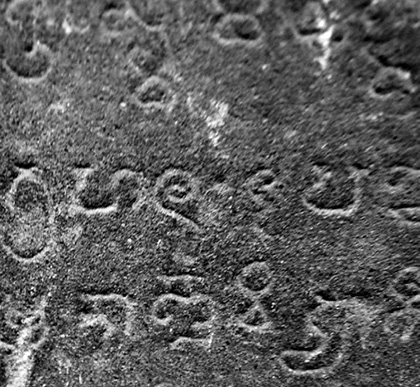
The face of the stele K-127, showing the ancient writings, including the number 605.
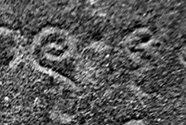
The numerals 605, the zero being the dot in the middle, from the photograph above.
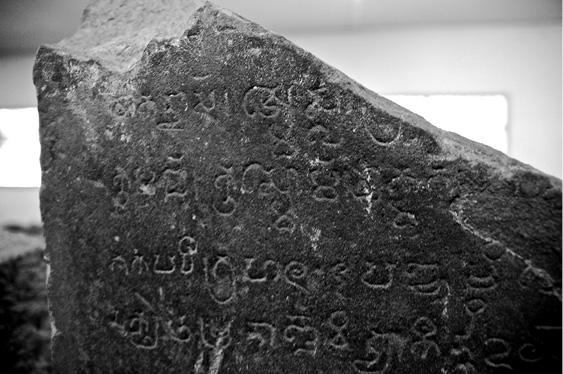
The upper part of artifact K-127, showing its broken top. The numerals 605 are on the second line from the bottom.
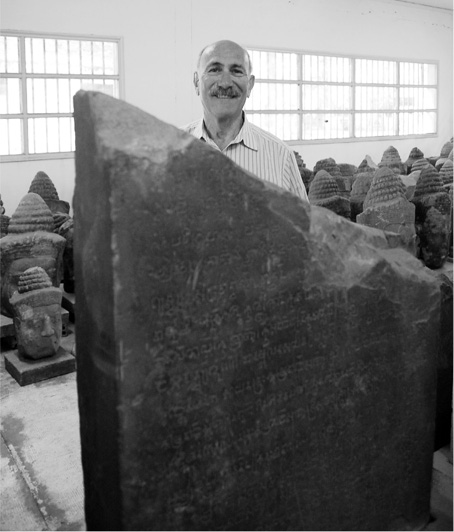
The author with K-127, right after verifying the discovery.
I imagined what happened later. The stele was discarded, placed in a desolate museum no one visited, moved to some unknown storage place among other abandoned objects, escaped destruction as Khmer Rouge thugs came rummaging through, smashing and burning and destroying anything of historical or artistic value. I saw it remain unnoticed and unharmed as destruction was perpetrated all around it; then it was moved once again, to come to an ignominious end in this shed in the middle of an empty field tucked in a jungle clearing. I closed my eyes and relaxed from the tension. Here it was, again. K-127. I looked very carefully at the ancient numerals.
After four years of hard work, I had found the CÅdès inscription. It took so much detective work, writing, calling, pleading; so much help from the highest levels of the Cambodian government, including the director of cultural affairs in the Ministry of Culture and Fine Arts; and the assistance of the Sloan Foundation, whose
kind, intelligent administrators were willing to help a researcher recapture a piece of our lost history. I was euphoric. My quest was over. I would now photograph the inscription, go home, and write down all that had happened to bring me to this moment of final triumph.
Yes, I finally found this red stone with the first zero ever madeâstill the first known zero of our system, after all these decades, to the best of our knowledge. I remained standing quietly next to the inscription and took many photographs of it.
And then I made my worst mistake.
22
There is a scene at the beginning of Steven Spiel
berg's iconic film
Raiders of the Lost Ark
in which Indiana Jones, played by Harrison Ford, goes through a harrowing set of experiences in a South American jungle, complete with skeletons on springs that come to life when a wire is tripped and shoot poison arrows at the intruder who dared penetrate their treasure's hideaway. Then despite the dangers and odds against him, he finds his prize, a golden idol. But just as he comes out of this great adventure, there is his arch enemy, the Nazi-collaborating French archaeologist René Belloq, who with pointed guns takes away the prize, saying, “Once again, Dr. Jones, something that was briefly yours is now mine!” He laughs as he hauls away the priceless archaeological find.
But Jones was smart and shrewdâhe was just temporarily outmaneuvered by his foe. I, on the other hand, acted stupidly. Had I said nothing and just walked away, my story would end here. But, like the proverbial crow that couldn't keep his mouth shut and lost the cheese to the wily fox, I opened my mouth. While Indiana Jones's nemesis was a male French archaeologist, mine would turn out to be a female Italian archaeologistâa Sicilian from Palermo.
While I was still gazing in awe and wonder at K-127, this remarkable inscription that was the culmination of a quest that had brought me halfway around the world, a pair of women researchers dressed in lab coats walked into thisârarely ever enteredâshed in the middle of a field in this nearly deserted compound in the wilds of Cambodia. They were chatting loudly in Italian.
Fond memories of my parents and my childhood sailings on the ship surfaced. Our ship often called at Italian ports, and I both speak well and love Italian. My father had studied navigation in Trieste, Italy, before becoming a captain, and my mother had taught herself Italian and was the president of the Haifa chapter of the Italian cultural society Dante Alighieri. I longed to speak it again, and in Asia I had little opportunity to do so. And the elation of having rediscovered K-127 made me more talkative than everâI had a need, a desire to share my exciting discovery with other people.
So I walked over to the two women and struck up a conversation; they seemed pleased to speak to someone who knew their own language. They introduced themselves as Lorella Pellegrino and Francesca Taormina. Taormina was blond and thin. Pellegrino was large, nearly six feet, with a round face framed with unruly, curly, and very dark hair.
I proudly pointed to the red inscribed stone and said, “This is K-127âit bears the oldest known zero in history.” They looked at it casually, and both said, “Really?” Then Pellegrino said, “How wonderful! Thank you so much for informing us about this.” She turned to face it, and with a small stick she was carrying casually hit the top of the stone, where the writing had been broken off centuries ago.
It made a loud thud. I almost faintedâhow could she be so crude and careless, slamming a hard stick against such a precious object? She seemed oblivious to my instinctive recoil and said, “You see, Francesca and I just came inside here to pick up one stone object at random to restoreâas practice for our archaeology studentsâso now we will pick this one, since you told us that it's so important.”
I had a sinking feeling in my stomach.
What have I done?
I asked myself. These two Italians were grabbing
my
findâright in front of meâafter so many years of my searching for it. Did they even fully understand its meaning to science history? They explained to me that they were both here by agreement between the Italian and Cambodian governments. Cambodia needed archaeologists to work on the vast ancient treasures found in this history-rich land, to learn to clean, catalog, and prepare artifacts for display in museums and exhibits. The two Sicilian archaeologists from the University of Palermo were training Cambodian students at a site near Angkor Conservation so that someday these students would become accomplished archaeologists and help preserve their nation's heritage.
Pellegrino and Taormina, just by chance, decided this day to come to the Angkor Conservation shed to select a random discarded artifact on which to practice archaeological “restoration” with their students. I tried to protest, saying that K-127 was an invaluable object of immense historical importance and that it should not be used as a guinea pig for students to make their mistakes with, spill paint on, or scratch the surface that had withstood the test of time, or perhaps drill into it or grind the facade. They ignored my protests.
“So it's a famous object,” Pellegrino said with a self-satisfied smile. “Good! I want the students to experience working with a valuable artifact, not just some old worthless stone. Thank you so much for pointing it out to us.” Before I could reply, the two women left the shed to make arrangements to move the heavy stone to their laboratory. I felt faint and powerless.
What could I do? Pellegrino and Taormina were in Siem Reap at the invitation of the Cambodian government. None of the Cambodians would dare oppose their decisionsâthey were respected professors from a faraway land and had been brought to teach the Cambodians sophisticated technical skills. And I was a visitor, given limited permission to enter the compound to look for a particular itemâwho was I to interfere with their work? I didn't own K-127âfar from it. By intergovernmental agreement, these two Italian professors controlled the artifacts found in this entire area. They could do as they pleased, and they had decided that K-127 was to be used as a learning tool in their lab. They owed no one an explanation.
I didn't want this piece touchedâand now they wanted to “restore” it? Restore
what?
It looked perfect as it was. The 1,330 years since it had been chiseled had left it remarkably free of signs of wear; a top segment had already broken off by the time it was found late in the nineteenth century, the part Pellegrino had just struck with her stick. Other than that, the stele was incredibly well preserved. Who would imagine restoring it? It seemed to me that Pellegrino and Taormina were teachersâthey wanted to demonstrate to students how to restore artifacts. Whatever item they chose, they only restored it to teach their students this craft. But
restoring such an artifact would only bring with it the risk of irreversible damage to an intact archaeological piece of evidence for a great human achievement.
Pellegrino and Taormina came back into the shed, smiling. “It will be moved to our lab in a couple of weeks,” Taormina said with apparent satisfaction. And then Pellegrino turned toward me and said, “When you will come back to visit us, you will find the inscription beautiful and restored.”
My God,
I thought,
who could ever save it from them now?
I was angry and frustrated and tried to quickly think of a solution.
K-127 belonged to the Cambodian people and deserved to be exhibited, as is, in a museum. I did not understand Pellegrino's insistence on taking it into her labâwhy would she need such an important artifact to teach restoration work? It made absolutely no sense to me. I began to suspect that she had another motive: Was she planning to try to pass it off as her own discovery, by publishing an academic paper, perhaps?
And there was something else. It was an issue that archaeology has grappled with for a hundred years. Around the turn of the twentieth century, the great English archaeologist Arthur Evans uncovered the palace of the legendary King Minos at Knossos on the north coast of Crete, the palace Homer described as containing the labyrinth in which the Minotaurâhalf bull, half manâwas confined to roam. In 1628 BCE, a volcano eruption on the island of Santorini created a tsunami that destroyed the palace and the royal city, bringing to an abrupt end the entire Minoan civilization.
1
Evans did something innovativeâand controversial. He “restored” the palace of Knossos. Where a statue of a lion once stood,
perhaps, he placed a statue found elsewhere; noticing traces of red paint on it, he repainted it with modern red paint. Where he thought some canals had been built during the Minoan age, he reconstructed them. Where a roofed courtyard loomed over the coastline, he attached a new roof. A visit to the site of Knossos is, therefore, quite different from a visit to any other archaeological site in the world. What Evans did at Knossos had not been done beforeâat least not to the same extentânor, perhaps, would ever be done again. Visiting Knossos today is seeing Evans's view of what it
might
have been likeâor not.
As we strolled away from K-127, Pellegrino turned to me and said, “Ah, since you're here, why don't you come visit our lab? Soon we will place K-127 there and work on it.” My legs were shaking as we entered a small, air-conditioned building in which a handful of young Cambodian trainees were restoring fifteenth- and sixteenth-century (thus, post-Angkor) wooden Buddha statues. A middle-aged Italian professor with a trimmed gray beard supervised the work. Pellegrino brought me over to him.
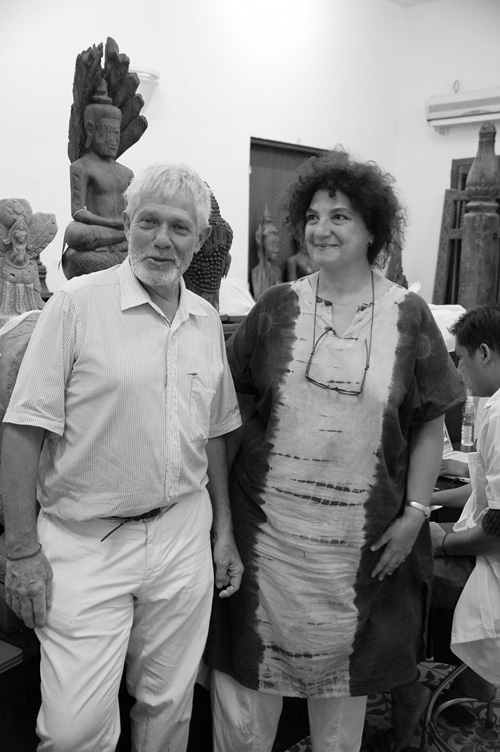
Professors Antonio Rava and Lorella Pellegrino in their lab near Siem Reap.
“This is Professor Antonio Rava,” she said, introducing us to each other. Rava was from the University of Turin in northern Italy and had the typical accent of that region, which is close to French (he pronounced the
r
as a French person would, in contrast to the rolling way it is pronounced in most other parts of Italy). He spoke perfect English. “You see, there is very little interest in the post-Angkor era,” he said, “so we pretty much have it all to ourselvesânobody cares about these wooden Buddhas made after the fall of the Angkor empire in the fourteenth century. So we restore them, make them beautiful.”
Sure,
I thought,
and now you'll do whatever
you please to one of the most important artifacts ever found in this country, whose authorities have given you carte blanche to do with antiquities as you desire.
But I smiled politely and followed him.
We walked through the lab. At one table a student painted with modern gold color a wooden Buddha statue that showed traces of once having been gilded. Two students were trying to attach a new pedestal to yet another statue. They pushed and twisted and hammered. We walked over, and Rava gave them some instructions and help. Finally, he announced loudly “It fits!,” and everyone clapped. Where did the pedestal come from? Nobody knew. It had been found in a pile of statue parts that sat outside the lab, Rava informed me. And there was a statue that lacked an arm, and another Cambodian archaeology student was attempting to attach an arm to itâI had to wonder where that arm came from.
This was not even archaeology as Evans would do it. This was a travesty. I knew from talking with conservators that state of the art methods now emphasize stabilizing an artifact to prevent further deterioration from insects or environmental elements while retaining the integrity of the piece and altering it as little as possible. “When you will come back, you will see how beautifully restored and shining will be the K-127,” Pellegrino said as my tour of the lab ended and she showed me to the door. I thought I discerned a mischievous smile on her face, as if to say, “Something that was briefly yours is now mine!” Or maybe it was my overactive imagination responding to the great excitement and stress of this long day.
With a heavy heart,
I left Siem Reap for Bangkok. In an e-mail message I told Bill Casselman of the University of British
Columbia, the mathematician who had first led me to CÅdès, what had happened. He was clearly furious. “What if they take it to Italy?” he fumed. “And from your photos it is clear that the inscription is in perfect condition and has an invaluable patinaâif it is destroyed by their work, this priceless find in the history of mathematics will be worthless and lost forever.” He thought it was clear that Lorella Pellegrino now wanted the credit for this find. Casselman offered to write to her, so we both wrote e-mail messages to Pellegrino, in the name of historians of mathematics, pleading with her not to disturb the artifact.
After a sleepless night for me, on January 3 Pellegrino relented somewhat and wrote that she would not “restore” the artifact. “However, I will study it thoroughly, and report the results to the world of science,” she wrote me in Italian. I took this to mean that she considered the find her own. I was relieved she wouldn't harm it, as she said. Still, we had to do something to save K-127 more permanently. But what? “Maybe she'll forget about it, do her other work,” Debra wrote me in an e-mail. I had a feeling that Pellegrino would not stop. She had fallen upon an important find, and I guessed that she would do everything she could to make it hers. Maybe all the restoration teaching stuff was just a smokescreenâan excuse to take possession of the artifact.
